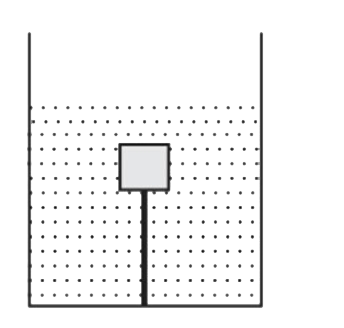A glass of radius 10−3 and density 2000kgm−3 fall in a jar filled with oil of density 800kgm−3 .The terminal velocity is found to be 1 cm/s. Calculate the coefficient of viscosity of oil
The correct Answer is:0.261Nsm−2
To calculate the coefficient of viscosity of oil when a glass sphere falls through it, we can use the formula for terminal velocity in a viscous fluid. The formula is given by:
vt=29⋅r2⋅gη⋅(ρs−ρl)
Where:
- vt = terminal velocity
- r = radius of the sphere
- g = acceleration due to gravity
- η = coefficient of viscosity
- ρs = density of the sphere (glass)
- ρl = density of the liquid (oil)
Step 1: Rearranging the formula
We need to solve for the coefficient of viscosity η. Rearranging the formula gives us:
η=29⋅r2⋅gvt⋅(ρs−ρl)
Step 2: Substituting the known values
Now we will substitute the known values into the equation:
- Radius r=10−3 m
- Density of glass ρs=2000 kg/m³
- Density of oil ρl=800 kg/m³
- Terminal velocity vt=1 cm/s = 0.01 m/s (conversion from cm/s to m/s)
- Acceleration due to gravity g=9.8 m/s²
Substituting these values into the equation:
η=29⋅(10−3)2⋅9.80.01⋅(2000−800)
Step 3: Calculating the differences in density
Calculate ρs−ρl:
ρs−ρl=2000−800=1200 kg/m3
Step 4: Plugging in the values
Now substituting this back into the equation:
η=29⋅(10−6)⋅9.80.01⋅1200
Step 5: Simplifying the expression
Calculating the terms step by step:
1. (10−3)2=10−6
2. 9.80.01=980
3. Now substituting these values:
η=29⋅10−6⋅980⋅1200
Step 6: Final calculation
Calculating the coefficient of viscosity:
η=2⋅980⋅1200⋅10−69
Calculating 2⋅980⋅1200=2352000:
η=2352000⋅10−69=2.352⋅1039≈261.33⋅10−3 Pa.s≈0.261 Pa.s
Conclusion
Thus, the coefficient of viscosity of the oil is approximately:
η≈0.261 Pa.s
- vt = terminal velocity
- r = radius of the sphere
- g = acceleration due to gravity
- η = coefficient of viscosity
- ρs = density of the sphere (glass)
- ρl = density of the liquid (oil)
We need to solve for the coefficient of viscosity η. Rearranging the formula gives us:
Now we will substitute the known values into the equation:
- Radius r=10−3 m
- Density of glass ρs=2000 kg/m³
- Density of oil ρl=800 kg/m³
- Terminal velocity vt=1 cm/s = 0.01 m/s (conversion from cm/s to m/s)
- Acceleration due to gravity g=9.8 m/s²
Calculate ρs−ρl:
Now substituting this back into the equation:
Calculating the terms step by step:
2. 9.80.01=980
3. Now substituting these values:
Calculating the coefficient of viscosity:
Thus, the coefficient of viscosity of the oil is approximately:
Topper's Solved these Questions
- MOTION IN FLUIDS BOOK - ICSECHAPTER - MOTION IN FLUIDS EXERCISE - SELECTED PROBLEMS (FROM POISEUILLE.S FORMULA)
19 Videos
- MOTION IN FLUIDS BOOK - ICSECHAPTER - MOTION IN FLUIDS EXERCISE - SELECTED PROBLEMS ( FROM PRESSURE, ARCHIMEDES. PRINCIPLE)
7 Videos
- INTERNAL ENERGY BOOK - ICSECHAPTER - INTERNAL ENERGY EXERCISE - SELECTED PROBLEMS (FROM HEAT ENGINES)
21 Videos
- OSCILLATIONS BOOK - ICSECHAPTER - OSCILLATIONS EXERCISE - SELECTED PROBLEMS (OSCILLATION IN A TUNNEL BORED THROUGH THE EARTH)
2 Videos
Similar Questions
A small metal ball of diameter 4mm and density 10.5g/cm3 in dropped in glycerine of density 1.5g/cm3. The ball attains a terminal velocity of 8cms−1. The coefficient of viscosity of glycerine is
View SolutionA small metal ball of diameter 4mm and density 10.5g/cm3 in dropped in glycerine of density 1.5g/cm3. The ball attains a terminal velocity of 8/cms−1. The coefficient of viscosity of glycerine is
View SolutionCalculate the molarity of water if its density is 1000kgm−3
View SolutionA spherical glass ball of mass 1.34×10−4 kg and diameter4.4×10−3m takes 6-4s to fall steadily through a height of 0-381 m inside a large volume of oil of specific gravity 0.943. Calculate the coefficient of viscosity of oil.
View SolutionWhat is the mass of 5m3 of cement of density 2000kg/m3 ?
View SolutionAn iceberg of density 900kg/m3 is floating in water of density 1000kg/m3. The percentage of volume of ice cube outside the water is
View SolutionAn iceberg of density 900kg/m3 is floating in water of density 1000kg/m3. The percentage of volume of ice cube outside the water is
View SolutionA steel ball of radius 2×10−3m is released in an oil of viscosity 0.232Nsm−2 and density 840kgm−3. Calculate the terminal velocity of ball. Take density of steel as 7800kgm−3
View SolutionA wooden block of mass 1kg and density 800Kgm−3 is held stationery, with the help of a string, in a container filled with water of density 1000kgm−3 as shown in the figure. If the container is moved upwards with an acceleration of 2ms−2, then the tension in the string will be ( takeg=10ms−2)

View SolutionThe density of copper is 8.9gcm−3 . What will be its density in kg m−3
View Solution
